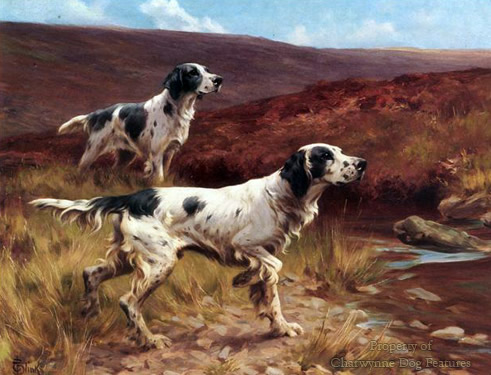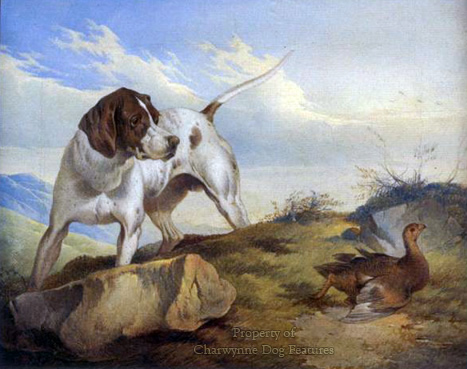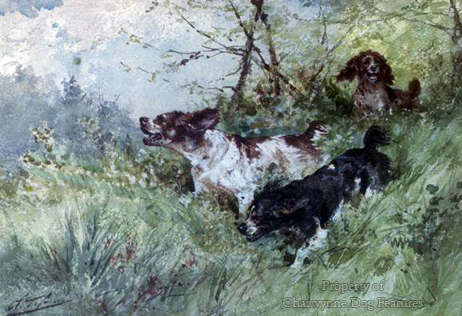511 Scenting Success
SCENTING SUCCESS
by David Hancock
Show me, if you can, one scientific instrument which is able to detect and locate: blood and bodies, arson and ivory, drugs and explosives, melanomas and bladder-cancer, dry and wet rot, human scent, specific animal scent, cows in oestrus, termites and toxic waste, moonshine, truffles, fruit and vegetables, counterfeit money, bedbugs, DVDs, pythons, archeological remains and hyperglycaemia in diabetic patients. But these are the scents dogs are being used to sniff out, despite a wealth of scientific research to find a mechanical alternative as effective. Man has profitably employed dog's scenting skills in the hunting and shooting field for many centuries, as the wide range of scenthound and gundog breeds illustrate. Whatever their breed differences, scenthounds from Finland and France have the same priceless attributes, as have their counterparts in America and Istria. Setters, pointers, braques and epagneuls may vary from Ireland to Italy and from Hungary to Holland, but scenting success is the shared skill.
Perhaps the greatest failing of man in his understanding of dog is his recurring inability to appreciate how dominant in the senses of the domestic dog is the sense of smell. For man the main detecting senses are sight and hearing, indeed I have read scientific papers claiming that our sixth sense only lapsed because of the high quality facility given to us by our eyes and ears. I have also read articles in country magazines extolling the superb eyesight of dogs, which I find hard to justify. I have never come across a dog with better all-round eyesight than man, although we will never be able to match their remarkable detection of movement. Never too will any of us ever match the quite astonishing sense of smell in dogs.
One of my dog-owning neighbours was recently quite apologetic to me because she always took her dogs on the same country walk. Each time she walks that route she sees the same scenes and gets very used to the appearance of the scenery within sight. But for her dogs each of those walks is a different experience despite following the same route each day. For across that path, farm animals, wild creatures, other dogs and fresh humans have moved and every day the smells will vary. This is the stimulation which the astounding sense of smell in dogs reacts to, savours and needs for the fullness of its life. For the domestic dog, nosework beats telly-watching by a mile! 
The scenting powers of dog have attracted the attention of the scientists; Droscher in 1971 found that a barefooted man leaves roughly four billionths of a gram of "odorous sweat substance" with each step he takes. Budgett in 1933 found that water formed 99% of such a gram in the first place. In locating this minute sweat sample, the tracking dog has to overlook the accompanying, conflicting and much more powerful surrounding smells -animal, vegetable and mineral...and most men on the run wear shoes! The experiments of the Russian psychiatrists Klosovsky and Kosmarskaya on puppies led them to believe that the senses of smell and taste were so interconnected that they were virtually acting as one, and, could in general, act interchangeably.
I have noticed when using dogs on a trail that the dog's head is carried higher during morning tracking, perhaps because the air is rising bringing the scent with it. It is also noticeable that scenting ability varies from individual to individual dog even within a breed; I suspect too that it is the determination and sheer persistence of the Bloodhound which makes it so effective at following cold trails, just as much as its scenting powers. Using Labradors, as tracker-dogs in the Malayan emergency, showed me that scenting prowess isn't enough by itself; you need a fanatic like a Bloodhound for really testing trails. Although the contemporary physique bestowed on this breed in the show ring is a serious handicap in the field.
A dog's sense of smell is probably several hundred times as powerful as ours. Research has shown that an amazing one-third of a dog's brain is allocated to scent detection alone. The GSD has an olfactory area of 170 sq cms, compared to a Pekingese's 20 sq cms. The Peke however still has five times the olfactory area of a human. Studies in Labradors have revealed that: working lines produced the best sniffers; excessive attention-seeking was accompanied by poor search ability; dogs stressed by novel situations were less suitable for search work. The sheer sensitivity of the nose of dog allows it to specialise in hunting deer or fox, otter or hare, man or truffles and to locate avalanche victims, drugs, the wounded on the battlefield, explosives, temporary graves, dry rot, melanomas, the onset of epilepsy...even moonshine in America.
The tracking ability of the dog has been used to show that identical twins produce an identical odour. A dog can follow the trail of either twin after smelling an article belonging to one of them, although cases have been recorded of a gifted dog actually differentiating between the two. This tracking ability can be impaired by temperature change, rain, humidity, frost, wind, competing odours and the sheer passage of time. But no human or machine produced by man would get on such a trail in the first place. This tracking skill backed by dog's response to training is a valuable element in the unique man-dog partnership. Pigs employed to locate truffles usually eat them!
The American Kennel Club's tracking dog trials in 1996 revealed that of 84 title winners only two were by scenthounds, a Beagle and an Otterhound. Golden Retrievers won 15 titles. They, along with Labradors and Malinois, are the favoured breeds there for drug, bomb or search and rescue work. Bloodhounds are famous for their ability to persevere with an original trail, with GSDs, Boxers and Dobermanns more likely to be diverted by cross-trails. A Dutch Shepherd has been assessed as worth his weight in gold, after detecting millions of counterfeit dollars in the USA. The US Customs Service declared that annually dogs' nose-skill leads to well over 6,000 arrests. 
The Russian airline Aeroflot has helped to develop a ‘super- sniffer dog' in their campaign to defeat terrorists and drug- smugglers. Crossing a Siberian Husky with a Turkoman Jackal has produced a dog with scent-detection skills for the extreme cold, which can suppress smells. The jackal has a nose even more sensitive than the domestic dog but is hard to train and afraid of humans. The Husky blood, contributing 3/4 to the blend, brings low temperature skills and greater biddability. These hybrids can work in extreme winter temperatures too. Each dog is estimated to be worth around £4,000 and other airlines in northern countries have expressed interest in them.
The more perceptive writers on dogs have long appreciated the overriding importance of the canine sense of smell. Wilson Stephens in his quite excellent Gundog Sense and Sensibility has written: "To gundogs, with centuries of nose-consciousness bred into it, noses are for serious business, eyes merely come in useful occasionally"... going on to state that he had never needed to teach a dog to use its nose but usually had to teach one to mark the fall of game using its eyes.
'Wildfowler' in his Dog Breaking, of 1915, gave his list of setter qualities in this order; "Nose, pace, energy, style and indomitable endurance". ..no doubt in his mind of the value to man of dog's sense of smell. But to limit scenting powers just to the nose is not entirely correct. In his informative The Mind of the Dog (1958), R.H.Smythe recorded this information: "Now, odours, scents or smells represent the delights of paradise to every dog...it is well known that delicate smells make the mouth water. Saliva dissolves the scent-bearing vapours and so the dog not only smells them but also tastes them. It is believed that hounds use both smell and taste, especially when the scent becomes strong, and it is believed by many that when hounds 'give tongue' they are actually savouring the delightful odour as it dissolves in their saliva." In pursuit of this belief our ancestors utilised the "shallow flew'd hound" to hunt by sight and scent, in that order, as a "fleethound" and the "deep-mouthed hound" as a specialist scenthound. There is a link too between well-developed sinuses and the ability to track. The best trailers have the skull-conformation to allow good sinus development, adequate width of nostril and good length of foreface so that there is sufficient surface between the nostrils to house the smell-sensitive lining membrane. Scenthounds, gundogs and other hunting dogs depend on the shape of their skulls for their acute smell-discrimination. In pedigree breeds, the wording of the description of the skull in the breed standard can therefore directly influence the scenting prowess of the dog. The narrower skull of the terrier leads it to prefer to hunt by sight, show less interest in following a trail of scent yet, through selective breeding, show enormous interest in scent coming from below ground.
Imagine the delicacy of scent that allows a gundog, at some distance, to distinguish between a partridge and a lark, a pheasant and a woodcock. General Hutchinson, writing at the turn of the century in his classic work Dog Breaking of 1909 advised hunting pointers and setters together, stating on the subject of scent that..."on certain days --in slight frost, for instance, --setters will recognise it better than pointers, and, on the other hand, that the nose of the latter will prove far superior after a long continuance of dry weather".. .The different breeds often display definite strengths in such a way and so too do individual dogs.
Following a trail "hot-footed" at great pace demands not only a "fast nose", i.e. superb coordination between detection and reaction, nose to brain, but also the anatomical capability of physical response too. The legendary Foxhound, Mr. John Smith- Barry's "Bluecap (1759)", took part in a famous match-race in 1762 over a four-mile distance on Newmarket racecourse. The ground was reportedly covered in just over 8 minutes. Sixty horses started with the four foxhounds but couldn't last the pace, only twelve finishing. Yet the hounds had to run and follow a trail! "Bluecap", it was alleged, covered ground at a mile every two minutes, approximately the speed of a Derby winner. I wonder what time this hound would have achieved just running with its head up. His 3 year-old daughter, incidentally, came a close second in this match. 
But "flying the country" is not the essence of scenthound work; the skill in unravelling a confused scent, the music of the hounds and the teamwork of the pack is the core of hunting pleasure with hounds following by scent. "Questing and melody" in such hounds has long been greatly valued and the considerable skill needed to pursue poor scent always much admired. In stag-hunting, the most trusted hounds, the tufters, exercise great scenting skill in deciding on the right line to get the pack laid on and the desired quarry isolated from the remainder; only a dog can do this. The sensory skill of the domestic dog is, well, simply sensational.
It could be that with the contemporary pressures on country sports, not just those arising from differing social attitudes but more from the increasing loss of country in which packs of hounds can operate, we need to find new outlets for hounds which follow scent. Hound trailing in the Lake District gives great pleasure to both people and hounds and offends no one. Perhaps a revival of match-races in which Foxhounds or comparable breeds take part in speed trials on draglines in the wake of "Bluecap's" feat would fulfil a need. So too could scent-matches in which the slower foothounds could prove the quality of their nosework on confused trails, where time was less important than accuracy. Come on you fanciers of Beagles and Bassets, Grand Bleu de Gascogne and Hamiltonstovares, Ridgebacks and Podengos; even in the show dogs, the heritage is there and the instincts merely dormant. Even Masefield pondered a century ago, on scenthound skills:
"Whence this sagacity, this wondrous pow'r,
Of tracing step by step or man or brute?
What guide invisible points out their way,
O’er the dank marsh, bleak hill and sandy plain?"